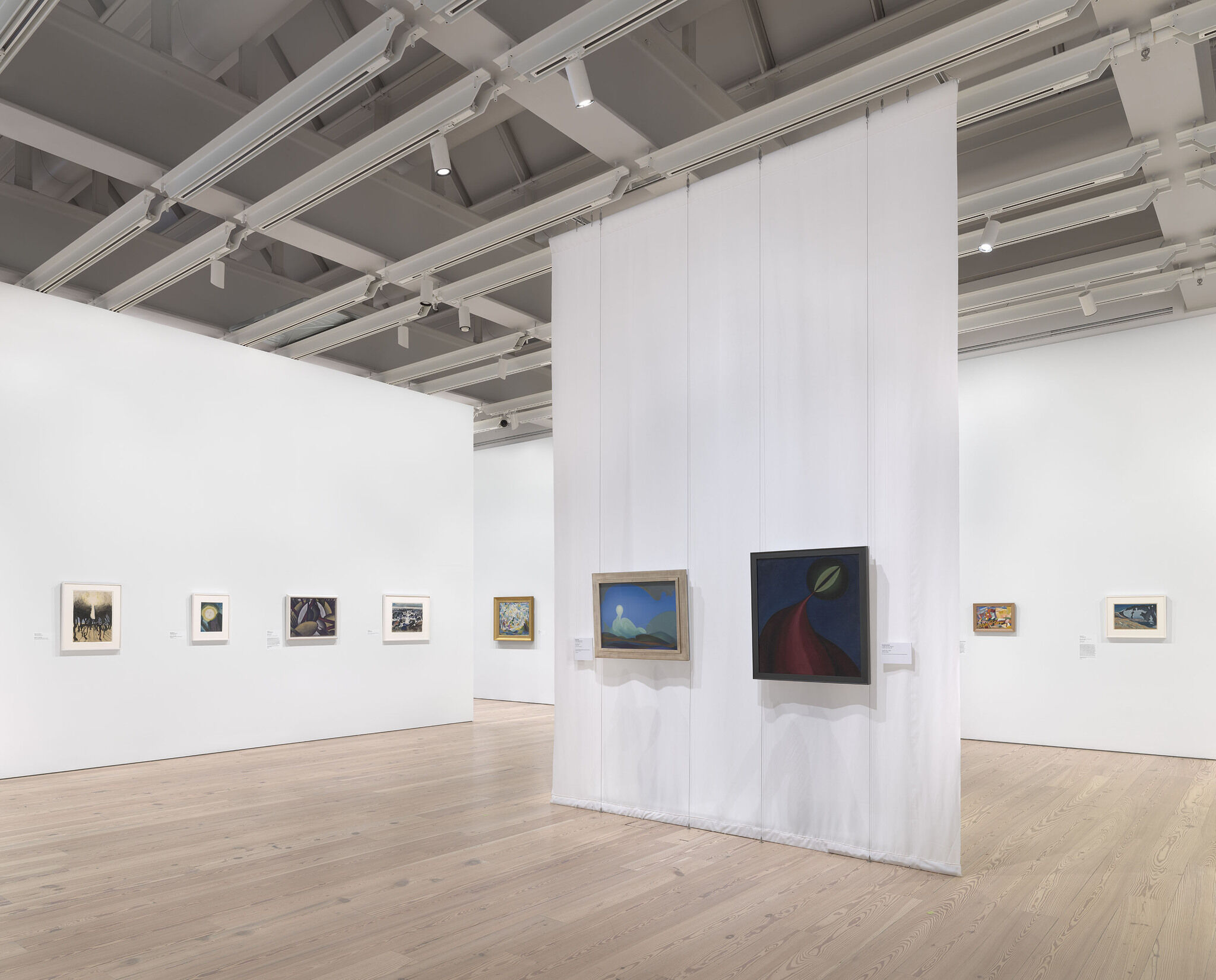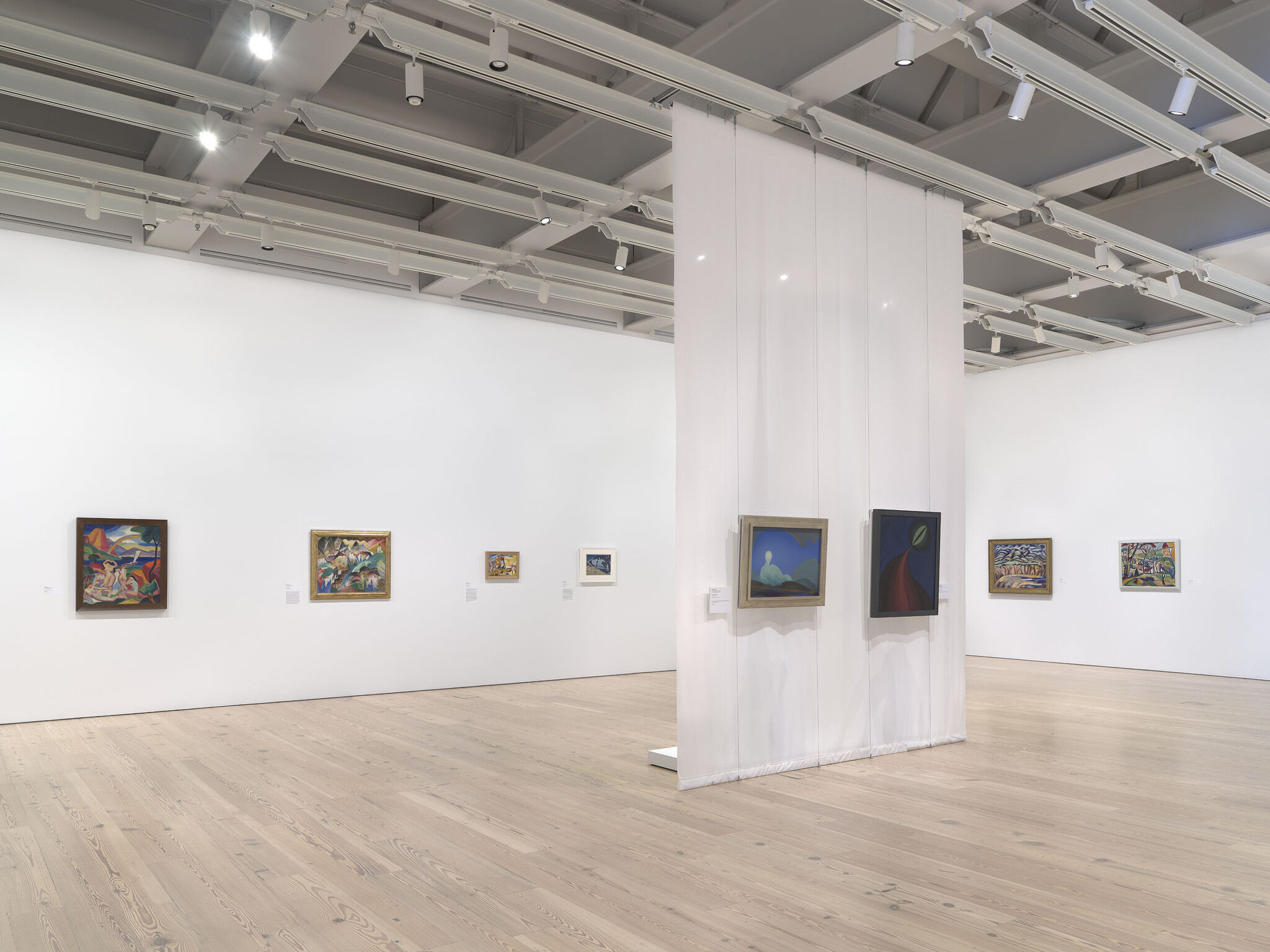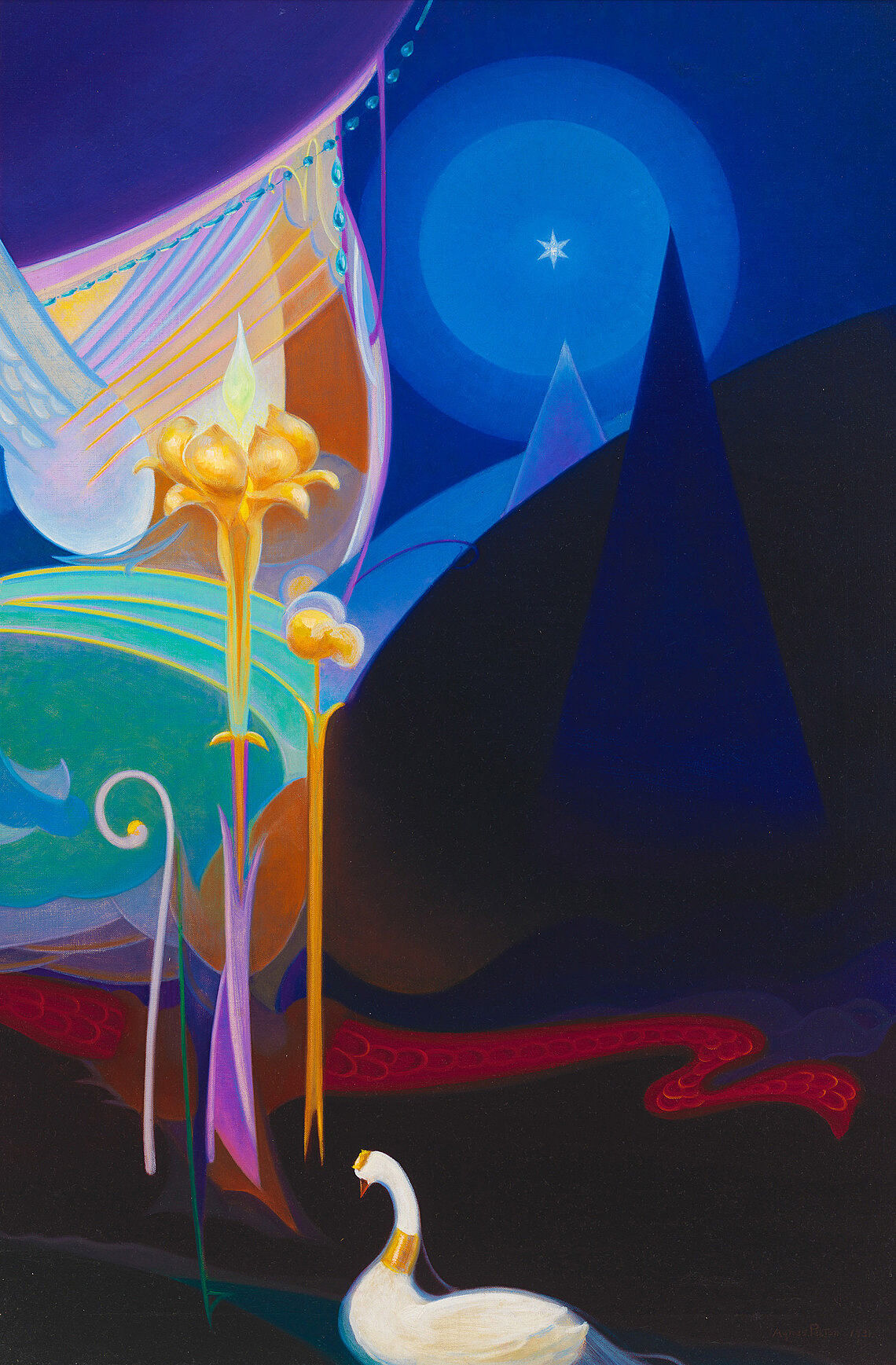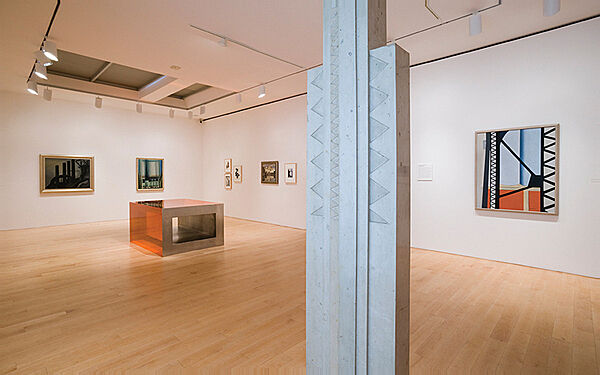Audio
-
Agnes Pelton, Sea Change
In At the Dawn of a New Age: Early Twentieth-Century American Modernism (Spanish)
0:00
Agnes Pelton, Sea Change
0:00
Carrie Moyer: Hace mucho tiempo que me interesa la obra de Agnes Pelton. Supongo que la consideraríamos una especie de pintora trascendentalista de mediados del siglo XX. Se trata de una mujer que, inventa para sí misma el tipo de espiritualidad que quiere practicar, y eso forma parte de estas pinturas.
Narrator: La pintora Carrie Moyer nos habla de la obra de Agnes Pelton, Sea Change.
Carrie Moyer: La paleta de Pelton es realmente fenomenal, en el sentido de que hay cierta dulzura que se siente lejana o separada de aquello que concebimos como parte de la naturaleza, ¿verdad? Todo se presenta en un color muy exagerado y saturado.
No sabemos exactamente qué lugar es este. Sabemos que es como un espacio mental y el color nos lo dice, ya que no parece tener una relación directa con lo que se observa. Es esta sensación intensa de... Es casi como si estuviéramos mirando una luz muy profunda desde una cueva; tal vez es el crepúsculo o algo por el estilo.
Y luego tenemos una especie de locomotora art decó, pero también es como una nube que tiene una cabeza extraña y brillante. Por eso parece que el término sea change (“cambio del mar”) es un cambio mucho más radical que una mera cuestión de naturaleza, ¿verdad? El cambio es una especie de metamorfosis, o algo así. Creo que es la pintura más intrigante, porque es realmente difícil determinar dónde se encuentra esta figura en términos del paisaje. ¿Está situada en el horizonte? ¿Está en erupción? ¿Se está deslizando? Está haciendo todo eso.
-
0:00
Agnes Pelton, Sea Change
0:00
Carrie Moyer: I have been interested in Agnes Pelton for a really long time. I guess we would consider her a kind of transcendentalist painter from the mid-twentieth century. So it's this woman who's self-inventing the kind of spirituality that she wants to practice, and that becomes part of these paintings.
Narrator: The painter Carrie Moyer spoke to us about Agnes Pelton’s Sea Change.
Carrie Moyer: Pelton's palette is really phenomenal in terms of it has a kind of like sweetness to it that feels so away or separated from things we think of as being from nature. Right? So everything is this very heightened, saturated color.
We don't know exactly where this is. We know that it's a sort of mental space, and the color tells us that because it doesn't seem to have a direct relationship to observation. It's this heightened sense of. It's almost like we're looking out from a cave or something into this really deep light, maybe dusk or something.
And then there's, one could call it a kind of art deco locomotive, but it's also like a cloud that has this crazy glowing head on it. So it feels like the term "sea change" is much more than talking about nature. Right? It's about a sort of change of morphing or something. I just think it's the most intriguing painting, because it's really hard to figure out where this form is in terms of the landscape. Is it like sitting on the horizon? Is it erupting? Is it gliding? It's doing all of those things.
-
0:00
Sea Change, 1931
0:00
Suzanne Hudson: It's clearly imaging some kind of wave form. But the longer I looked at it, I realized that it actually is both kind of aqueous and celestial. It could be the movement of water, but it could also be the movement of sky.
Narrator: Like many of her peers, Pelton was interested in the writing of the Swiss psychiatrist Carl Jung. For Jung, water and passage through water served as metaphors for the collective unconscious and rebirth. Suzanne Hudson is a professor of art history at the University of Southern California.
Suzanne Hudson: I see her within a trajectory of American artists who in some ways it's a kind of pantheism or kind of appropriation from so many different religious traditions and sources. It becomes almost a kind of homemade faith or a kind of spirituality by her own design. And I think, in that, you could put her together with people like Agnes Martin or many other artists who were interested in so many different world religions and practices. Not as a form of hierarchy, or not as a form of conventional structured religion, but as ways of trying to understand themselves in their relation to something far beyond.
Exhibitions
Installation photography
-


Installation view of At the Dawn of a New Age: Early Twentieth-Century American Modernism (Whitney Museum of American Art, New York, May 4, 2022-January 2023). From left to right: Charles Burchfield, Sunlight in Forest, 1916; Oscar Bluemner, #8. June – Moon, 1927; Arthur Dove, Plant Forms, 1912; John Marin, White Horses – Sea Movement off Deer Isle, 1926; Joseph Stella, Der Rosenkavalier, 1913-14; Agnes Pelton, Sea Change, 1931; Henrietta Stone, Trail of Life, 1923; Yun Gee, Street Scene, 1926; Chiura Obata, Silence, Last Twilight on an Unknown Lake, Johnson Peak, 1930. Photograph by Ron Amstutz
From the exhibition At the Dawn of a New Age: Early Twentieth-Century American Modernism
-


Installation view of At the Dawn of a New Age: Early Twentieth-Century American Modernism (Whitney Museum of American Art, New York, May 4, 2022-January 2023). From left to right: Carl Newman, Untitled (Bathers), c. 1917; Albert Bloch, Mountain, 1916; Yun Gee, Street Scene, 1926; Chiura Obata, Silence, Last Twilight on an Unknown Lake, Johnson Peak, 1930; Agnes Pelton, Sea Change, 1931; Henrietta Shore, Trail of Life, c. 1923; Marsden Hartley, Landscape, New Mexico, 1919-20; Henry Lyman Sayen, Valley Falls II, c. 1915. Photograph by Ron Amstutz
From the exhibition At the Dawn of a New Age: Early Twentieth-Century American Modernism
-


Installation view of At the Dawn of a New Age: Early Twentieth-Century American Modernism (Whitney Museum of American Art, New York, May 4, 2022-January 2023). From left to right: Georgia O’Keeffe, Black and White, 1930; William Zorach, Woods in Autumn, 1913; Agnes Pelton, Sea Change, 1931; Henrietta Shore, Trail of Life, 1923. Photograph by Ron Amstutz
From the exhibition At the Dawn of a New Age: Early Twentieth-Century American Modernism
-


Installation view of Agnes Pelton: Desert Transcendentalist (Whitney Museum of American Art, New York, March 13–November 1, 2020). From left to right: Voyaging, 1931; Sea Change, 1931; Sand Storm, 1932. Photograph by Ron Amstutz
From the exhibition Agnes Pelton: Desert Transcendentalist
-


Installation view of Agnes Pelton: Desert Transcendentalist (Whitney Museum of American Art, New York, March 13–November 1, 2020). From left to right: Voyaging, 1931; Sea Change, 1931; Sand Storm, 1932; Return, 1940; Ahmi in Egypt, 1931. Photograph by Ron Amstutz
From the exhibition Agnes Pelton: Desert Transcendentalist





